#Deep Portugal - Viseu
Explore tagged Tumblr posts
Text
Portugal, day 7
Our seventh day in Portugal was a traveling one; we left Viseu and headed back south to Lisbon. We decided to make a detour to the coast, stopping in Figueira da Foz (literally "fig tree of the (river) mouth"), a touristy beach town on the Atlantic.
Because it was a Sunday in July, I was expecting the worst in terms of traffic, parking, and crowds, but it was surprisingly empty. We easily found a parking spot and an empty table at a beachside restaurant (which called itself an "Irish pub" but served Portuguese food).

I ordered pasteis de bacalhau and Michele ordered bolinhos de alheira (sausage balls), and we each ordered a side salad. The waiter showed up with three side salads and acted like we had somehow ordered three of them, despite the fact that there were clearly two of us, and in what world would two people order three side salads? But he very magnanimously did not charge us for the third side salad that we neither ordered nor ate.

After lunch, we walked down one of the extremely long boardwalks that went down from the sidewalk toward the water. The beach at Figueira da Foz is extremely deep; I swear we must have walked half a mile when the boardwalk ended and the ocean was still way off in the distance.

The lot where we parked our car was also home to the most abandoned active carnival I've ever seen. I think I saw one child on a bumper car and that was it. A large Ferris wheel slowly turned with all of its carriages obviously empty. I accidentally took this very artistic photo when I was trying to capture the massive number of seagulls in the sky.

The Ferris wheel, though empty, looked pretty nice (apparently it's the largest one in Portugal, at around 100 feet), so we decided to go for a ride. The ticket booth was empty, but eventually an 8-year-old boy showed up, followed by a man who was presumably his father, who loaded us up into a carriage for our three rotations. (He offered to give us more, because there wasn't exactly a line, but turns around a Ferris wheel have sharply diminishing returns so we declined.)
We got some nice views of the town, including a medieval fortress and a really sad ocean-themed bouncy house.


We also saw a seagull taking a little ride on top of the next Ferris wheel car over.

Ferris having been fully wheeled, we packed back into the car and completed the drive back to Lisbon. Returning the car was a considerably more streamlined process than picking it up, in that it took about 5 minutes instead of 120.
We checked into a hotel right by the airport, then headed to the Time Out Market, a large, bustling food court by the water.

I was hoping to eat arroz de pato again before leaving Portugal, and thankfully that was the Sunday special at one of the booths, so we both ordered it, and took our food to the Miradouro de Santa Catarina, one of Lisbon's many scenic lookout points, for a picnic dinner.


We watched the sunset for a bit, then headed back to our hotel. It was a lovely cap to our trip, and a microcosm of sorts — delicious food, beautiful scenery, and marginally annoying but manageable crowds of tourists.
The next morning we flew back to Chicago, and thus ends this installment of EAK Does Europe!
1 note
·
View note
Text
TASK 001.

FULL NAME : antónio afonso de bragança MEANING: an apt noble of incalculable worth, from the district of braga.
BASIC INFORMATION
FULL NAME : antónio afonso de bragança
MEANING :
antónio: of incalculable worth, worthy
afonso: 'noble', alternatively 'ready', 'apt' - the first king of portugal
bragança: from the capital city of braga, of the braga district
MONIKERS / NICKNAMES : nino ( family & close friends ), tonho ( vitoria )
TITLE : infante de portugal, duque de viseu/duque de beja, governador geral do brasil ( infante of portugal, duke of viseu, governor-geral of brazil )
GENDER & PRONOUNS :
cisgender male
he / his
ETHNICITY : white european & african black
DATE OF BIRTH & AGE : march 28th, 1531 / twenty-eight
ZODIAC SIGN : aries
ORIENTATION : bisexual biromantic
MARITAL STATUS : unmarried
OCCUPATION : governor-geral of brazil
CURRENT LOCATION : castelgrande castle, switzerland
BACKGROUND
PLACE OF BIRTH : lisboa, portugal
RESIDENCES : paço da ribeira
RELIGIOUS VIEWS : roman catholicism
EDUCATION : antónio was educated accordingly for a second son in his time - firstly in how to behave properly as a royal, then to fulfill what was expected of him at all moments. he was raised to be a skilled strategist and counselor for his father and his older brother, who will one day assume the throne. aside from being taught his duties as infante, antónio had tutors for many of his interests - some that his father deemed useful for him as a prince, some that he didn't (such as specific subjects in arts and literature). antónio has great swordsmanship and horsemanship, as well as well stretched social skills that range from the lowest to highest social class.
LANGUAGES SPOKEN : portuguese ( native ), latin ( fluent ), spanish ( fluent ), english ( fluent ), italian ( conversational ) french ( conversational ), german ( learning )
ALLEGIANCES :
house of bragança ( first, by birth )
brazilian colony ( second, by vocation )
the holy roman empire & its allies ( third, by tact )
FAMILY :
king joão of portugal ( father )
queen carlota of barcelos ( mother, deceased )
beatriz of portugal, queen of spain ( sister )
prince sebastião ( brother )
infanta vitória ( sister )
OTHER FAMILIAL RELATIONS :
archduchess louisa of portugal ( aunt )
grand duchess augusta of styria ( cousin )
grand duke lucas of carinthia ( cousin )
archduke augustinus of bavaria-munich ( uncle )
king alonso of spain ( brother-in-law )
tomás, duke of barcelona ( brother-in-law )
infanta luciana ( sister-in-law, deceased )
infanta mariana ( sister-in-law )
infanta teresa ( sister-in-law )
manuel, prince of asturias ( nephew )
infante cristóbal ( nephew )
infante miguel ( nephew )
infanta inés ( niece )
infanta carlota ( niece )
APPEARANCE
FACECLAIM : keiynan lonsdale
HAIR COLOUR / STYLE : black in color. cut short, well trimmed and cared for, in an unusual manner for the time.
EYE COLOUR / SHAPE : deep set, black eyes, piercing in stare.
HEIGHT : 1.83 m / 6'0’’
BUILD : athletic in build ; little body fat due to extensive athletic leisure, toned but proportionate muscles..
SPEECH STYLE : antónio is a soft spoken young man, with vast rhetorical knowledge, which he uses accordingly to social situations. his portuguese accent is always present and considerably heavy to the ears, and he will speak in his mother tongue whenever he can. when talking amongst his cared for, he will enthusiastically ramble and often get lost in his own thoughts. in official situations (or around his father), his tone and speech pattern will change, turning into a calmer, more responsible sounding tone, proper of a young infante. antónio seeks to always better represent his country and family.
RECOGNIZABLE MARKINGS : squared jaw
BEAUTY HABITS : bathes regularly, likes infused water with herbs and flowers (the latter mostly for aesthetic pleasure). takes care of dental hygiene (accordingly to the time). carries a nosegay when strolling through in public. wears bright colored attire, harmonious with his country colors - mostly red, golden and bege - in undershirts, trousers, tunics and cloaks, frequently uses leggigns for protection or belts to secure his trousers. sometimes will wear wrap-over coats and puffier sleeves for more official and/or social occasions.
PERSONALITY
TROPES : crowd pleaser, like a duck takes to water, wake-up call
INSPIRATIONS : i literally do not know?? maybe a bit on dom pedro i just because of the whole 'choosing the colony over the metropole, despite him being far from like dom pedro (also cause dom pedro is from the 1700s-1800s)
MBTI : enfp-t ; the campaigner
ENNEAGRAM : type 9 ; the peacemaker
ALIGNMENT : lawful good
TEMPERAMENT : sanguine ( melancholic, phlegmatic, choleric )
HOGWARTS HOUSE : hufflepuff
POSITIVE TRAITS : buoyant, altruistic, merciful, principled, loyal, tolerant, gregarious
NEGATIVE TRAITS : tactless, quixotic, lenient, hesitant, submissive
HABITS : switching between accents/dialects/languages, pacing, overly expressing physically, restless leg
HOBBIES : athletic leisure (quarter staff, jousting, archery, riding, hunting), music related pastimes (listening to music, playing the moorish guitar and the harpsichord), painting, literature (reading and writing poetry, troubadours), academic endeavors, social encounters (drinking involved) & sailing
USUAL DEMEANOR : surrounded by his closest and most trustworthy, antónio is a bright and light young man, talkative and friendly, full of ideas and easily excited. he stands goofily and doesn't appease to royal standards. amongst court, he's stiffer and less expressive, unless in defence of his family and country's honor, but is more of a listened than a talker - unless in festive environment, when he's capable to mix his public persona with his personal social talents, an energetic and magnetic man.
HEALTH
PHYSICAL AILMENTS : none worth mention. always an active and healthy child, antónio never suffered from grave illness, only usual summer fevers..
NEUROLOGICAL CONDITION : from a young age, tutors and staff noticed antónio's restlessness. even when doing things he enjoyed, he displayed anxious behaviors, such as inability to wait for his own turn, having difficulty maintaining attention in one task - description compatible with symptoms of ADHD-C. despite the hardships of his lack of focus and generalized anxieties, antónio grew up to be an emotionally intelligent man, although only mildly aware of his own emotional dependency on his father's opinions. aside from the above and the sleep disorder, which will be described later), antónio struggles with a sense of lack of self-awareness. not a complete disruption of perception, which would make him identifiable with a dissociative disorder, but mild enough to be considered a sort of dissociation from material reality, such as depersonalization, in which antónio is detached from his surroundings in midst of anxiety episodes and finds himself as a third-party, observant of himself, but is aware that the feeling is not reality. in defiance of all the above, antónio remains a light-hearted individual, usually seem as a happy young man. he would not describe himself as unhappy in any given time, but is aware of his inner turmoils - only to categorize them as usual human emotions. he has no intention of pursuing explanations for his behaviors, nor treatment for them (despite his father's constant attempts of calming him down as a child).
PHOBIAS : fear of disappointing his family, fear of being forgotten
ALLERGIES : none
SLEEPING HABITS : antónio has difficulties in falling asleep, and once he does, he might wake up several times throughout the evening. he's gone through weeks at a time with minimal amounts of sleep, but his overall appearance and posture is hardly affected by it. antónio suffers from episodes of dissociation during sleep, such as being unable to dream in first person, which affects him while awake as he sometimes has a hard time knowing if he's awake or dreaming. overall, antónio sleeps late when he does, just as sun's about to rise, and wakes up throughout his sleep several times, but eventually gets up around 3-5 hours later, average. when he has early duties, he often does not sleep.
SOCIABILITY : extremely extroverted, antónio will make a point to talk to as many people as he can in any given situation, whatever the matter is. he's constantly and impatiently looking for new acquaintances and companies, whether it be for sexual reasons or merely social ones. he is usually seen as the life of the party in many people's eyes. although he prefers writing, painting and studying by himself, all his other leisure activities are prefered to be done with groups of people. antónio is more than capable of spending good alone time, but prefers to keep the company of others.
ADDICTIONS : antónio is exhaustingly drawn to physical activity - for leisure and health purposes. considered addiction of not, he participates in competitions and tournaments often, thrilled by the adrenaline suppressed in it. besides that, he's not much of a heavy drinker, choosing to do so only in social gatherings or to impress someone (he's that guy). he enjoys the feeling of being drunk, and is always aware of his limitations with alcohol.
4 notes
·
View notes
Text
Phillipa of Lancaster: Queen of Portugal
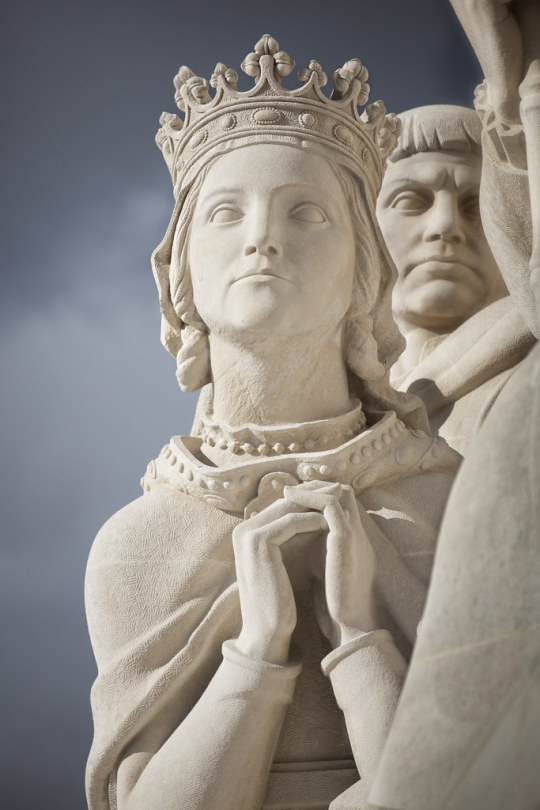
Philippa of Lancaster did not marry until she was twenty-six years old, quite late for a princess of her rank. Her father, John of Gaunt, arranged a splendid marriage for her in conjunction with an alliance with King Joao I of Portugal. Philippa and King Joao had a large, well-educated and accomplished family that came to be known as the “illustrious generation”.
Philippa was born on March 31, 1360 at Leicester Castle, the first child of her parents. Her father was John of Gaunt, one of the many sons born to King Edward III of England and his revered Queen, Philippa of Hainault. Princess Philippa was named after her grandmother. Philippa’s mother was Blanche, the daughter of Henry of Grosmont, Earl of Derby who distinguished himself at the naval Battle of Winchelsea in 1350 by saving John of Gaunt and his brother the Black Prince as their ship was sinking. Edward III awarded him by giving him the title of Duke of Lancaster. When Henry of Grosmont died of the plague ten days after receiving his title, Blanche inherited his wealth and John of Gaunt became the Duke of Lancaster.
Many of Grosmont’s castles went to Philippa’s parents. She was to spend a great deal of time at the Savoy Palace on the Thames in London as well as the castles of Hertford, Tutbury, Kenilworth and Bolingbroke. She had her own nurse named Maud. When she was three and a half, a sister named Elizabeth arrived. When Philippa was six years old, Geoffrey Chaucer married one of the Queen’s ladies, Philippa de Roet and began to work in the Lancaster household. Philippa de Roet had a sister named Katherine who also worked for the Queen. Katherine was to marry Sir Hugh Swynford and would come to have an immense influence on the life of Philippa of Lancaster. When Philippa was seven, her brother Henry was born.
John of Gaunt had gone to Spain to fight. While he was gone, the Black Death swept England. Blanche of Lancaster moved her children and household to Bolingbroke Castle in Lincolnshire in hopes of avoiding the disease. Unfortunately, Blanche succumbed to the Black Death on September 12, 1369. On the day she died, Katherine Swynford was there to visit Blanche. Katherine immediately took charge of Blanche’s three children. John of Gaunt returned to England in November. He had Blanche’s body transported to London and she was buried in St. Paul’s Cathedral.
Before she died, Blanche herself had begun to teach her daughters to read and write. Geoffrey Chaucer began to improve on these lessons. Chaucer had a deep interest in science, astrology and navigation. He even wrote a treatise on the astrolabe and taught Philippa how to use it. He also wrote an elegiac poem honoring Philippa’s mother. In addition to the teachings of Chaucer, she was taught poetry by Jean Froissart and philosophy and theology under John Wycliffe.
By 1371, Katherine Swynford had become the mistress of John of Gaunt. She was officially appointed governess to Philippa and her sister that same year. As governess, Katherine would have been responsible for teaching the girls courtly accomplishments and the ability to administer their own households. She probably taught them dancing, singing, conversation, good carriage and games. Many offers for marriage were considered for Philippa but nothing ever came of them.
John of Gaunt was acutely aware he would never inherit the crown of England so he sought a crown of his own. He contracted a marriage with the Infanta Costanza, the rightful heiress of the crown of Castile in September of 1371. From the day of his marriage he and Costanza were called the “King and Queen of Castile”. Within a year, Costanza had a daughter named Cataline.
In June of 1376, the Black Prince, heir to the throne died and in June of 1377, King Edward III died. The Black Prince’s son Richard became king at the age of ten. The Lancaster family was present at the coronation on July 16th. John of Gaunt was to take a large role in the government of the young king. That same summer, Philippa, her sister Elizabeth and her stepmother were all elected to the Order of the Garter and took part in the induction ceremony.
In 1381, the reign of Richard II was not going well and the people rose up against the government, with John of Gaunt being the object of their anger. An irate mob burned down his magnificent Savoy Palace in London. It was after this that John of Gaunt broke off relations with his mistress Katherine Swynford. Philippa lost her governess and significant change began in her life. She became closer to her stepmother and stepsister Cataline.
In 1385, the English Parliament approved the sending of an army to Portugal to support King Joao I and to enforce the claims of John of Gaunt to the kingdom of Castile. He took his family to await the arrival of the Portuguese fleet to transport the English army overseas. They sailed in July and arrived in Portugal and King Joao came to meet them. Joao and John admired each other immensely. Discussions ensued on the terms of the armies helping each other to attack Castile. They also discussed a marriage of Joao to one of Gaunt’s daughters. Most of the nobles were promoting Cataline as the wife of King Joao. But Cataline had ties to Portugal’s mortal enemy, Castile. Gaunt left the decision up to Joao to choose between Cataline and Philippa. He chose Philippa.
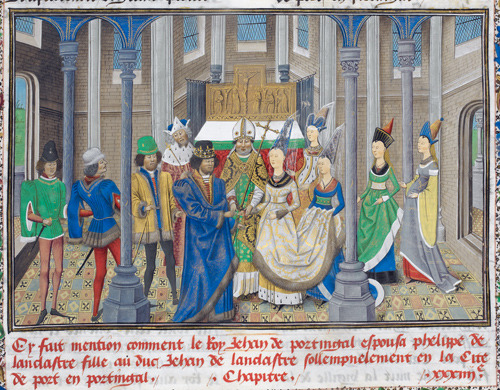
Philippa said goodbye to her family on November 10, 1386. She had to wait until papal dispensation arrived which it did on February 2, 1387. The marriage ceremony took place at Oporto on February 14th. The marriage was to be successful although Joao had two children from another woman called Inês Pires before he met Phillipa, after he married he was faithful to his wife, even after she died, he never re-married or had any other children, he stayed widower for 18 years until he died on August 14th 1433. He left to fight in Castille and Philippa proceeded to organize her court. She had an impact immediately. She was described as discreet, pious and modest, walking with her eyes lowered and her neck covered. She had a profound sense of duty. Many writers admired her behavior, if not her beauty. She was praised for her fair skin, blonde hair and blue eyes.
As far as possible, Philippa and Joao went everywhere together. They put forth the image of a loving and happy family. They agreed to name their first born child a Portuguese name if it were a boy and an English name if it was a girl and then alternate names, irrespective of sex. Their first child, born in 1388 was named Blanche after Philippa’s mother. They are recorded as having a total of eight children of which six survived childhood. These were the “illustrious generation”.
Edward Duarte was born in 1391. He was a writer and intellectual who succeeded his father as King. Peter was born in 1392. He was the first Duke of Coimbra and a well-traveled man who served as Regent during the minority of his nephew Afonso V. Henry the Navigator was born in 1394. He became the first Duke of Viseu and guided Portugal through the great era of The Discoveries. Isabella was born in 1397. She married Philip III, Duke of Burgundy and was one of the most powerful and admired women in Europe. John was born in 1400 and became the Constable of Portugal. The final child, Ferdinand, was born in 1402. He was known as the “Saint Prince” and died as a prisoner of the Moors.
Philippa supervised the education of all her children and Joao taught them riding, hunting, hawking and the art of the tiltyard. Philippa made an effort to be a friend to the common people and no part of the kingdom was too small for her to visit. Joao relied on her to administer his kingdom when he was away. In 1396, John of Gaunt finally married Katherine Swynford and their children were legitimized. In February of 1399, John of Gaunt died and Philippa traveled to England for the funeral. In September of that same year, Philippa’s brother deposed King Richard II and became King Henry IV. In August of 1400, King Joao was elected to the Order of the Garter, probably as a reward for being one of the first to recognize Henry as King of England.
The middle years of Joao’s reign were years of consolidation and growing prosperity for Portugal. In 1409, Philippa and Joao visited England. Peace was concluded with Castile in 1411. Philippa began to encourage her husband to act against the Moors. Joao was inspired to attack the fortified town of Ceuta, across from Gibraltar on the African continent. He discussed it with his sons and they all agreed to the expedition.
Ships were being readied to carry the troops in the hot summer of 1415 when plague broke out in Lisbon and Oporto. Philippa had succumbed to the disease. Joao had Philippa moved to the convent of Odivelas, high in the hills to the north of Lisbon in hopes she might recover. Philippa had three jeweled swords made. Her most cherished wish was for her husband to knight her three elder sons in her presence. She soon realized this wouldn’t happen. She made Joao promise he would knight them and presented the swords to her sons herself. She blessed them all. She called Isabel to her side. Isabel kissed her mother’s hands and received her blessing. The King arrived and sat by her side. On July 18, 1415, Philippa died at the age of 55. She was the first and only English Queen of Portugal.
Because of the extreme heat, the children advised that Philippa be buried immediately and secretly. She was temporarily buried in the convent of Odivelas and a funeral was held the next day. The whole Portuguese nation mourned their Queen. Joao and his sons sailed to Ceuta and easily conquered the town.

14 notes
·
View notes
Text
Coimbra | Centro de Portugal
youtube

Winner Artwork&Tur Worldwide Movie Competition – – 1st Prize Cultural Tourism
I had spent a lot of the morning on the Belvedere of the church of Santa Clara, admiring the fowl’s eye view of the Portuguese Metropolis of Data. I cringe my eyes, because the noon solar shines a highlight on the amalgam of white facades, terracotta roofs, church tops and bell towers that make up the town’s skyline. On the summit of the hill reverse, the previous college complicated is grotesquely undersized by colleges constructed within the 60’s; A dream of Olympus, they known as it!
Little or no is left of its 13th-century foundations. A lot of the Outdated College Advanced was integrated into the Royal Palace within the center ages when Coimbra was the Portuguese capital. Repeatedly refurbished all through the centuries, this multi-layered heritage centerpiece has, all through its historical past, been the Academy of selection of the nation’s most influential summa cum laude.
I’m not certainly one of these esteemed alumni, however rising up on this metropolis allowed me to share a valuable brotherhood reference to strangers, particularly now in September when a brand new batch of freshmen arrive. For me, that is ten occasions extra rewarding.
The principle school boulevard bears witness to the centuries-old pledging rituals that this academy is thought for. Older college students sporting their black conventional apparel and meticulously organized cassocks, introduce the newcomers to the artwork of social ice-breaking, by making them measure the size of the boulevard with a toothpick. Some methodically depend the white stones of figures current within the Portuguese Pavement. Others make life marginally simpler for themselves and easily climb the statue of the college’s founder, King Denis, to salute the Dean as he walks by.
On the finish of the boulevard, I cross by way of the Porta Ferrea, a five-meter excessive cast-iron gate, embellished with figures and symbols of knowledge, which guards the doorway to the complicated. Inside, an enormous courtyard is surrounded by ancestral buildings the place, nonetheless at present, the College of Regulation and the college’s workplaces function. On my proper, the 30 meters excessive College Tower tells the time with a 15-minute delay. A rule imposed by the scholar physique as leeway to these arriving late to class.
Contained in the Joanina Library, subsequent door, the air smells of information. “For those who look intently, you’ll discover that their eyes comply with you as you progress!” stated the library tour information in regards to the figures on the frescos that line the ceiling. Her enthusiasm is contagious and I proudly pitch in that it is without doubt one of the high 20 on the planet.
Outdoors, within the courtyard’s Belvedere, I discover I’m not in a position to admire the lofty cover of the adjoining botanical gardens. A lingering ache has set into the again of my neck, an apparent consequence of my extended admiration of the library’s frescos.
Immediately the courtyard fills up with individuals, elbowing one another in direction of the rising sound of a Fado chorus and the distinctive chords of the 12-string Coimbra guitar. Silence units within the second that deep male voice hits the primary lyrics of an improv serenade. Coimbra, very very like its Fado, tells deep tales of affection, significant companionship, and nostalgia about those that select this quiet city to turn into Males and Ladies.
You’ll be able to uncover extra about Coimbra right here: https://ift.tt/2gc8ncW
and extra in regards to the Centro de Portugal right here: https://ift.tt/2pG4BZF
Listed below are the hyperlinks to the opposite movies that includes the 6 journeys we made inside Centro de Portugal:
Serra da Estrela
youtube
Aveiro
youtube
Oeste
youtube
Viseu and Historic Villages
youtube
Unesco Heritage in Centro de Portugal
youtube
Centro de Portugal
youtube
This mission was made below the partnership between NelsonCarvalheiro.com (https://ift.tt/1MtZS2w) and the Centro de Portugal Tourism Bureau (https://ift.tt/2pG4BZF)
You’ll be able to comply with my work right here:
Web site:
Nelson Carvalheiro The Award Winning Travel Inspiration Blog
Instagram: https://ift.tt/2pGjCul
Fb: https://ift.tt/2FFJDrk
Twitter: Tweets by NCarvalheiro
E mail: [email protected]
Copyright and all rights reserved to NelsonCarvalheiro.com
Video Credit: Edited by Nelson Carvalheiro Photographs by Nelson Carvalheiro, Paulo Fajardo and Daniel Louro Concept and storytelling by WeChangers, primarily based in https://www.youtube.com/watch?v=M4CjhvrpX9g
Music: Skip Alongside the Ambiance by Cloud Revolution https://ift.tt/2pGmd7x
Cowl Photograph by Emanuele Siracusa : https://ift.tt/1IGv1hs source
from WordPress https://ift.tt/3caizfC via IFTTT
0 notes
Text
2013-2014 (Abridged)
De Zwaan. Sound, Urbanism and Sense of Place At: Viseu. Portugal. 18–20 July 2014. (Ao), (Cs).
Fat lip. thickear event At: Yard Theatre. Hackney Wick. London. June 2014. (P), (Pp), (Pw), *(Te).
How to do things with sound studies: Or, on the use of the ‘_’ word in my research. [And, the _o_ filter as a com_ositional device].
Transcribing Site. At: Parasol unit. London. 19 May 2014. (Pp), (Vp), (Pv), (Pw) / (Appendix 5).
Repetitive Reading and Rustling. Offering Rites 3: Beyond The Object At: Central Saint Martins. London. 12 April. 2014. (P), (Pw) / (Appendix 3).
Consumptive Beats #2. NOISE and whispers (Group show) At: GV Art Gallery. London. 8 November - 14 December. 2013. (I).
Rip It Up and Start Again. Are You Listening? At: Galleria Spazioersetti. Udine. Italy. 25 May. 2013. (Ao).
Flip-beep, Flop-beep. Go Deep or Go Home (Group show curated by The Hut Project) At: ASC Gallery, London. 17 Nov – 21 Dec 2012. (Ao), (I), (Pv).
0 notes
Text
MORE THAN 20 DEAD" AS PORTUGAL DECLARES STATE OF PUBLIC CALAMITY NORTH OF THE TEJO
Portugal woke up this morning to new fire horror. Twenty-six ‘monster blazes’ are sweeping across tens of kilometres from Leiria to Moncão. Six people were confirmed dead at 7am, that number has since risen to "more than 20". Hundreds of animals and livestock have perished. Over 3000 firefighters are ‘on the ground’ but it’s not enough. The government has declared a state of “public calamity” north of the Tejo river.
The words on people’s lips are “we’ve never seen anything like this”.
High winds, high temperatures - conditions remain stacked against populations and authorities as they battle to bring about some kind of change.
Early this morning, CMTV carried graphic footage with trees literally exploding in the background as reporters filed their footage.
One appealed to readers to open an atlas and plot the geographical points he was giving “just to get an idea of how big this particular fire is”.
The fire he was talking about, stretches over 34 kilometres between Tondela and Nelas, in the borough of Viseu.
But it is only one of the 26 still raging as reports talk of communities ‘left on their own’ - firefighters simply too overstretched to get everywhere.
The deaths began yesterday - dubbed Portugal’s “worst day of the year” for forest fires: two in Penacova, one in Sertã.
Since then two people have been confirmed dead in Oliveira do Hospital, another in Nelas, and then a sudden slew of new tragic numbers. According to reports, among the dead was a young pregnant woman.
Despite the forecast of rain, it has yet to arrive.
The country remains on ‘red alert’ until 8pm this evening.
Besides the dead, there are scores of injuries, four of which were seriously hurt in a car accident as they tried to flee a blaze in Aveiro.
There is even a report of someone killed as he/ she tried to flee on the A25 motorway on foot in Aveiro, but that has not yet been confirmed by Civil Protection national command.
Civil Protection’s spokesperson Patrícia Gaspar has nonetheless confirmed various failings in the SIRESP emergency communications network - the system that authorities are meant to rely on in these situations, and which has come under attack throughout this summer’s infernos.
Questioned over whether reinforcements would be arriving in the next few hours, Gaspar is quoted as saying: “All available means are committed”, and that the only ‘changes’ can involve moving authorities on the ground “from one fire to the next”.
Last night, she gave a new total for the day’s forest fires: 443 in the space of less than 12 hours, 108 of which remained “active, of elevated complexity”.
“Various villages have been evacuated” as a result of the blazes in Moncão, Seiã and Lousã, while dozens of roads and stretches of motorways remain closed.
As light returns, hopes are that today somehow ends on a better note.
Air support from Morocco is on the way - perhaps with the declaration of public calamity, firefighters and equipment from Spain and France will also be forthcoming.
To follow the picture nationally access fires website fogos.pt, or tune in to any of the major television networks, CMTV carrying some of the most dramatic footage as journalists venture deep into the areas ravaged by flames.
São noticias terríveis, calamitosas e de partir o coração. Nestas alturas as palavras falham, as emoções esmagadoras. Rezamos por todos afectados e por dias melhores. Nestas alturas, a nossa fé, seja que acreditamos ou não, é uma forma de comforto. O Nosso Senhor olha por nós. Eu acredito nisso com todo o meu coração.
0 notes
Text
15th King of Portugal (6th of the Aviz Dynasty): King João III of Portugal, “The Pious/ The Colonizer”

Reign: 13 December 1521 – 11 June 1557 Acclamation: 19 December 1521 Predecessor: Manuel I
John III (7 June 1502 in Lisbon – 11 June 1557 in Lisbon) nicknamed The Colonizer ("o Colonizador") was the King of Portugal and the Algarves from 13 December 1521 to 11 June 1557. He was the son of King Manuel I and Maria of Aragon, the third daughter of King Fernando II of Aragon and Queen Isabel I of Castile. João succeeded his father in 1521, at the age of nineteen.
During his rule, Portuguese possessions were extended in Asia and in the New World through the Portuguese colonization of Brazil. João III's policy of reinforcing Portugal's bases in India (such as Goa) secured Portugal's monopoly over the spice trade of cloves and nutmeg from the Maluku Islands, as a result of which João III has been called the "Grocer King". On the eve of his death in 1557, the Portuguese empire had a global dimension and spanned almost 1 billion acres (about 4 million square kilometers).
During his reign, the Portuguese became the first Europeans to make contact with both China, under the Ming dynasty, and Japan, during the Muromachi period. He abandoned Muslim territories in North Africa in favor of trade with India and investment in Brazil. In Europe, he improved relations with the Baltic region and the Rhineland, hoping that this would bolster Portuguese trade.

João, the eldest son of King Manuel I to his second wife Maria of Aragon, was born in Lisbon on 7 June 1502. The event was marked by the presentation of Gil Vicente's Visitation Play or the Monologue of the Cowherd (Auto da Visitação ou Monólogo do Vaqueiro) in the queen's chamber.
The young prince was sworn heir to the throne in 1503, the year his youngest sister, Isabel of Portugal, Empress Consort of the Holy Roman Empire between 1527 and 1538, was born.
João was educated by notable scholars of the time, including the astrologer Tomás de Torres, Diogo de Ortiz, Bishop of Viseu, and Luís Teixeira Lobo, one of the first Portuguese Renaissance humanists, rector of the University of Siena (1476) and Professor of Law at Ferrara (1502).
João's chronicler António de Castilho said that, "Dom João III faced problems easily, complementing his lack of culture with a practice formation that he always showed during his reign" (Elogio d'el rei D. João de Portugal, terceiro, do nome). In 1514, he was given his own house, and a few years later began to help his father in administrative duties.

At the age of sixteen, João was chosen to marry his first cousin, the 20-year-old Leonor of Austria,

eldest daughter of Philip the Handsome of Austria-Burgundy

and Queen Joana of Castile,
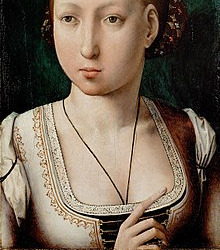
but instead she married his widowed father Manuel. João took deep offence at this: his chroniclers say he became melancholic and was never quite the same. Some historians also argue this was one of the main reasons that João later became fervently religious, giving him name the Pious (o Piedoso).
On 19 December 1521, João was crowned king in the Church of São Domingos in Lisbon, beginning a thirty-six-year reign characterized by extensive activity in internal and overseas politics, especially in relations with other major European states. João III continued the absolutist politics of his predecessors. He called the Portuguese Cortes only three times and at great intervals: 1525 in Torres Novas, 1535 in Évora and 1544 in Almeirim. During the early part of his reign, he also tried to restructure administrative and judicial life in his realm.
The marriage of João's sister Isabel of Portugal to Holy Roman Emperor Charles V,
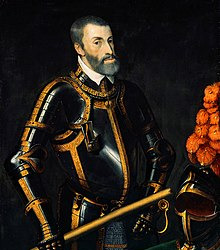
enabled the Portuguese king to forge a stronger alliance with Spain and the Holy Roman Empire. To strengthen his ties with Austria, he married his maternal first cousin Catherine of Austria, younger sister of Charles V and his erstwhile fiancée Leonor, in the town of Crato. João III had nine children from that marriage, but most of them died young. By the time of João's death, only his grandson Sebastião was alive to inherit the crown.
The large and far-flung Portuguese Empire was difficult and expensive to administer and was burdened with huge external debt and trade deficits. Portugal's Indian and Far Eastern interests grew increasingly chaotic under the poor administration of ambitious governors. João III responded with new appointments that proved troubled and short-lived: in some cases, the new governors even had to fight their predecessors to take up their appointments. The resulting failures in administration brought on a gradual decline of the Portuguese trade monopoly. In consideration of the challenging military situation faced by Portuguese forces worldwide, João III declared every male subject between 20 and 65 years old recruitable for military service on 7 August 1549.
Among João III's many colonial governors in Asia were Vasco da Gama,

Pedro Mascarenhas,

Lopo Vaz de Sampaio,

Nuno da Cunha,

Estêvão da Gama,

Martim Afonso de Sousa,
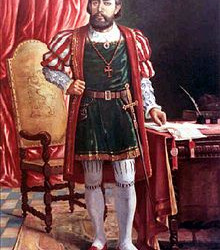
João de Castro

and Henrique de Meneses. Overseas, the Empire was threatened by the Ottoman Empire in both the Indian Ocean and North Africa, causing Portugal to increase spending on defense and fortifications. Meanwhile, in the Atlantic, where Portuguese ships already had to withstand constant attacks of Privateers, an initial settlement of French colonists in Brazil created yet another "front". The French made alliances with native South Americans against the Portuguese and military and political interventions were used. Eventually they were forced out, but not until 1565.
In the first years of João III's reign, explorations in the Far East continued, and the Portuguese reached China and Japan; however, these accomplishments were offset by pressure from a strengthening Ottoman Empire under Suleiman the Magnificent,
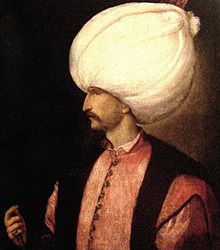
especially in India, where attacks became more frequent. The expense of defending Indian interests was huge. To pay for it, João III abandoned a number of strongholds in North Africa: Safim, Azamor, Alcácer Ceguer and Arzila.
João III achieved an important political victory in securing the control of the Maluku Islands, the "Spice Islands" claimed by Spain since the Magellan-Elcano circumnavigation. After almost a decade of skirmishes in Southeast Asia, he signed the Treaty of Zaragoza with Emperor Charles V on 22 April 1529. It defined the areas of Spanish and Portuguese influence in Asia and established the anti-meridian to the Treaty of Tordesillas.
The reign of João III was marked by active diplomacy. With Spain, he made alliances through marriage that ensured peace in the Iberian Peninsula for a number of years. He himself married Catherine of Austria, the daughter of Philip I of Castile. His sister Isabel of Portugal married Charles V, the king of Spain and Holy Roman Emperor. His daughter Maria Manuela

married King Felipe II of Spain

– and there were others. However, the intermarriage of these closely related royal families may have been one of the factors that contributed to the poor health of João's children and of future King Sebastião of Portugal.
João III remained neutral during the war between France and Spain but stood firm in fighting the attacks of French privateers.
He strengthened relations with the Papal States by introducing the Inquisition in Portugal and the adhesion of the Portuguese clergy to the Counter-Reformation. This relationship with the Catholic Church made it possible for João to name whomever he desired to important religious positions in Portugal: his brothers Henrique and Afonso
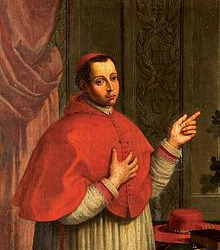
were made Cardinals, and his biological son, Duarte; was made Archbishop of Braga.
Commercial relations were intensified with England, the countries of the Baltic regions and Flanders during João III's reign. Meanwhile, at the other end of the world, Portugal was the first European nation to make contact with Japan. In China, Macau was offered to the Portuguese, and soon Portugal controlled major trade routes in the area. In South Asia, the Portuguese continued its hostile stance against their Muslim rivals and insurgent Indian leaders.
João III's support for the humanist cause was significant. In literature, his active support of Gil Vicente,
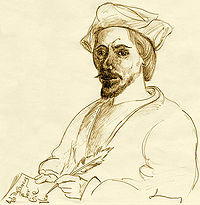
Garcia de Resende,

Sá de Miranda,

Bernardim Ribeiro,
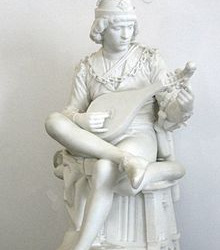
Fernão Mendes Pinto,

João de Barros
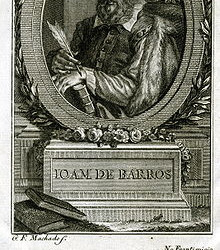
and Luís de Camões
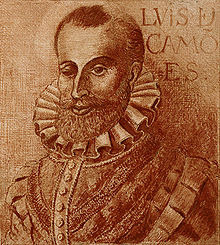
was notable. In the sciences, João III supported the mathematician Pedro Nunes
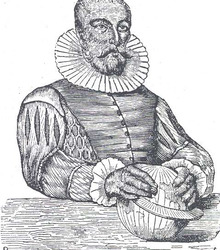
and the physician Garcia de Orta.

Through his links to Portuguese humanists such as Luís Teixeira Lobo, Erasmus dedicated his Chrysostomi Lucubrationes to João III of Portugal in 1527.
The monarch awarded many scholarships to universities abroad, mainly in the University of Paris, where fifty Portuguese students were sent to the Collège Sainte-Barbe headed by Diogo de Gouveia. He definitively transferred the Portuguese university from Lisbon to Coimbra in 1537.

In 1542 João III created in Coimbra a College of Arts (Liberal arts) for which he quickly recalled the many prominent Portuguese and European teachers headed by André de Gouveia at the College of Guienne in Bordeaux. Those included George Buchanan,
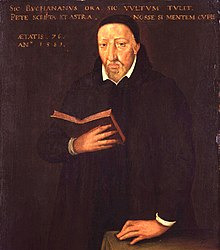
Diogo de Teive, Jerónimo Osório, Nicolas de Grouchy, Guillaume Guérante and Élie Vinet, who were decisive for the dissemination of the contemporary research of Pedro Nunes. The king provided the university with excellent resources. However, the importance of the College was shadowed by rivalry between the orthodox views of the "Parisians" group headed by Diogo de Gouveia and the more secular views of the "Bordeaux" school headed by his nephew André de Gouveia, within the advent of the Counter-Reformation and the influence of the Society of Jesus. The Society of Jesus founded colleges and made education more widely available.
Another noteworthy aspect of João III's rule was the support he gave to missionaries in the New World, Asia and Africa. In 1540, after successive appeals to Pope Paul III asking for missionaries for the Portuguese East Indies under the "Padroado" agreement, João III appointed Francis Xavier to take charge as Apostolic Nuncio. He had been enthusiastically endorsed by Diogo de Gouveia, his teacher at the Collège Sainte-Barbe, and advised the king to draw the youngsters of the newly formed Society of Jesus.The Jesuits were particularly important for mediating Portuguese relations with native peoples.
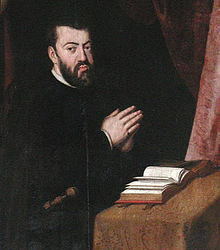
The Inquisition was introduced into Portugal in 1536. As in Spain, the Inquisition was placed under the authority of the king.
The Grand Inquisitor, or General Inquisitor, was named by the Pope after being nominated by the king, and he always came from within the royal family. The Grand Inquisitor would later nominate other inquisitors. In Portugal, the first Grand Inquisitor was Cardinal Henrique the king's brother (who would later himself become king).
There were Courts of the Inquisition in Lisbon, Coimbra and Évora and, from 1560 onwards, in Goa. The Goa Inquisition changed the demographics of Goa considerably. Goa was called the "Lisbon of the Far East" and trade reached a new level.
The Portuguese did not leave Goa undeveloped, rather they introduced modern architecture and built strong roads and bridges that have stood the test of time even till today.
The activities of the Inquisition extended to book censorship, repression and trial for divination, witchcraft and bigamy, as well as the prosecution of sexual crimes, especially sodomy.
Originally created to punish religious deviance, the Inquisition came to have influence in almost every aspect of Portuguese society: politics, culture and social customs. It did serve to spare Portugal the civil upheavals of religious warfare of the sort that occurred in France and elsewhere in Europe during the 16th century.

In João III's time, trade between the Portuguese and Africans was extremely intense in feitorias such Arguim, Mina, Mombasa, Sofala or Mozambique. Under João III, several expeditions started in coastal Africa and advanced to the interior of the continent. These expeditions were formed by groups of navigators, merchants, adventurers and missionaries. Missions in Africa were established by the College of Arts of Coimbra. The objective was to increase the king's dominion, develop peaceful relations and to Christianize the indigenous peoples. Relations with local rulers were often complicated by trade in slaves, as shown by João's correspondence with them.
João III refused to abandon all of the Portuguese North African strongholds, but he had to make choices based on the economic or strategic value of each possession. João III decided to abandon Safim and Azamor in 1541, followed by Arzila and Alcácer Ceguer in 1549. The fortresses of Ceuta, Tangiers and Mazagan were strengthened "to face the new military techniques, imposed by the generalization of heavy artillery, combined with light fire weapons and blades".
João III's court jester was João de Sá Panasco, a black African, who was eventually admitted to the prestigious Order of Saint James based on his service in the Conquest of Tunis (1535).
Before the reign of João III, the Portuguese had already reached Siam (1511), the Maluku Islands (1512), the Chinese littoral (1513), Canton (1517) and Timor (1515). During João's rule, the Portuguese reached Japan, and at the end of João's reign, Macau was offered to Portugal by China. From India, João III imported an amazing variety of spices, herbs, minerals, and fabrics; from Malacca, exotic woods and spice; from Bengala, fabrics and exotic foodstuffs; from Alexandria and Cairo, exotic woods, metals, minerals, fabrics, and boullion; and from China, musk, rhubarb, & silk in exchange for gromwells, pearls, horses from Arabia and Persia, non-worked silk, silk embroidery threads, fruits of the date palm, raisins, salt, sulphur and many other goods.
As Muslims and other peoples constantly attacked Portuguese fleets in India, and because India was so far from mainland Portugal, it was extremely difficult for João III to secure Portuguese dominion in this area. A viceroy (or Governor-General with extensive powers) was nominated, but this was not enough to defend the Portuguese possessions in India. The Portuguese started by creating feitorias – commercial strongholds in Cochin, Cannanore, Coulão, Cranganore and Tanor – with the initial objective of establishing just a commercial dominion in the region.
The hostility of many Indian kingdoms and alliances between sultans and zamorins to expel the Portuguese made it necessary for the Europeans to establish a sovereign state. Portugal thus militarily occupied some key cities on the Indian coast, and Goa became the headquarters of the Portuguese Empire in the East as of 1512. Goa became a starting point for the introduction of European cultural and religious values in India, and churches, schools and hospitals were built. Goa remained an overseas possession of Portugal until India reclaimed it in 1961.
The Portuguese arrived in Japan in 1543. Japan had been known in Portugal since the time of Marco Polo,

who called it "Cipango". Whether Portuguese nationals were the first Europeans to arrive in Japan is debatable. Some say the first Portuguese arrival was the writer Fernão Mendes Pinto, and others say it was the navigators António Peixoto, António da Mota and Francisco Zeimoto.
Portuguese traders started negotiating with Japan earlier than 1550 and established a base there at Nagasaki. By then, trade with Japan was a Portuguese monopoly under the rule of a Captain. Because the Portuguese established themselves in Macau, Chinese commercial relations, mainly the silver trade with Japan, were improved under João III's rule.
After the voyage of Fernão de Magalhães
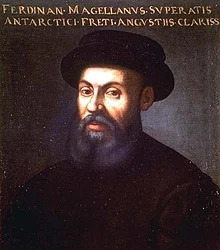
the Crown of Castile claimed the recently discovered Maluku Islands. In 1524, a conference of experts (cartographers, cosmographers, pilots, etc.) was held to solve the dispute caused by the difficulty of determining the meridian agreed to in the Treaty of Tordesillas. The Portuguese delegation sent by João III included names such as António de Azevedo Coutinho, Diogo Lopes de Sequeira, Lopo Homem and Simão Fernandes. The dispute was settled in 1529 by the Treaty of Zaragoza, signed by João III and Carlos I of Spain. The Portuguese paid 350,000 gold ducados to Spain and secured their presence in the islands, which not have been a necessity, as Portugal was actually entitled to the islands according to the Treaty of Tordesillas.
In 1553, Leonel de Sousa obtained authorization for the Portuguese to establish themselves in Canton and Macau. Macau was later offered to João III as a reward for Portuguese assistance against maritime piracy in the period between 1557 and 1564. Malacca, which controlled the eponymous Strait of Malacca, was vital to Portuguese interests in the Far East. After an unsuccessful expedition in 1509, Malacca was finally conquered by Afonso de Albuquerque, the Portuguese viceroy of India, on 24 August 1511. Malacca was later taken by the Dutch in 1641.
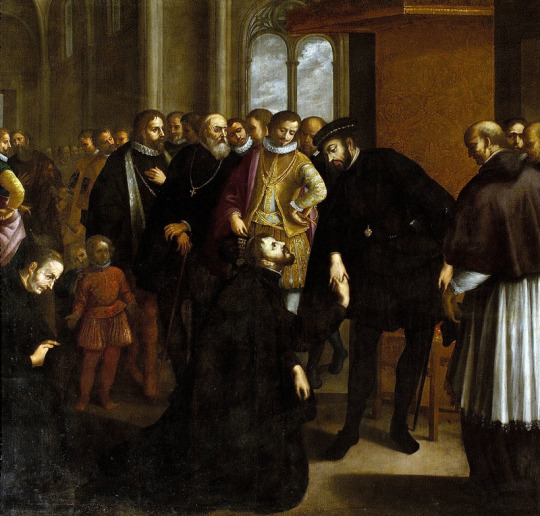
In order to follow its trade routes to the Far East, Portugal depended on the seasonal monsoon winds in the Indian Ocean. In winter, the prevailing northeasterly monsoon impeded travel to India; in summer, the southwest monsoon made departure from India difficult. As a result, Portugal determined that it needed permanent bases in India, in addition to its ports of call in Africa, to pass the time while the wind changed. In addition to Goa, they established themselves in Ceylon (in what is now Sri Lanka) through the conquest of several Ceylonese kingdoms in the sixteenth century. Portuguese Ceylon remained in Portuguese hands until 1658, when it was seized by the Dutch after an epic siege.
During the reign of King João III, the Portuguese Empire established itself in South America with the foundation of the twelve Captaincy Colonies of Brazil (from 1534 onwards). Each with its own donatary captain, the twelve colonies struggled independently. In 1549, João III established the Governorate General of Brazil, and the twelve captaincy colonies became subordinate to it. The first Governor-General appointed by João III, Tomé de Sousa, founded the city of Salvador, Bahia (São Salvador da Bahia de Todos os Santos) in 1549.
Immediately following the discovery of Brazil in 1500, the Portuguese imported brazilwood, Indian slaves and exotic birds from there. Brazilwood was a much appreciated product in Europe, because it could be used to produce a red dye. During João III's rule, after the initial colonization, Portuguese explorers intensified the search for brazilwood and began the cultivation of sugarcane, which was well suited to the climate of Brazil, especially around Recife and Bahía.
In the final years of João's reign, Portugal's colony of Brazil was just beginning its rapid development as a producer of sugar that compensated for the gradual decline of revenues from Asia, a development that would continue during the reign of his grandson and successor, Sebastião (1557–1578). Since Brazil lacked a large native population, and the Indians did not make good plantation workers, the Portuguese colonists began to import African slaves to work their plantations. The first slaves, from the region of Guinea, arrived in Brazil in 1539. Most of them worked in the sugarcane fields or served as house servants.
From 1539, the heir to the throne was João Manuel, Prince of Portugal,

who married Joana of Austria, Princess of Portugal,

daughter of Charles V. The sole son of João III to survive childhood, Prince João, was sickly and died young (of juvenile diabetes), eighteen days before his wife gave birth to Prince Sebastião on 20 January 1554. When João III died of apoplexy in 1557, his only heir was his three-year-old grandson, Sebastião. João III's body rests in the Monastery of Jerónimos in Lisbon, next to his wife.
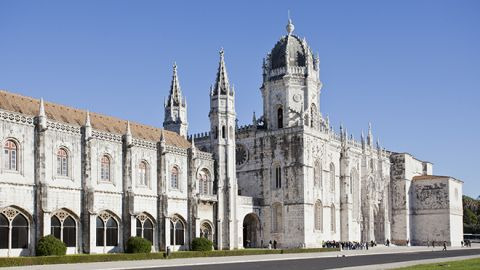

With his wife Catarina of Austria (married 10 February 1525) he had 9 nine children:
Prince Afonso (24 February 1526 - March 1526) Prince of Portugal (1526).
Princess Maria Manuela (15 October 1527 - 12 August 1545) Princess of Portugal (1527–1531). Princess consort of Asturias by marriage to King Philip II of Spain, then Prince of Asturias. She had one deformed child, Prince Carlos, and she died a few days after his birth.
Infanta Isabel (28 April 1529 - 28 April 1529)
Infanta Beatriz (15 February 1530 - 15 February 1530)
Prince Manuel (1 November 1531 - 14 April 1537) Prince of Portugal (1531–1537). Declared heir in 1535.
Prince Filipe (25 March 1533 - 29 April 1539) Prince of Portugal (1537–1539). Declared heir in 1537.
Infante Dinis (6 April 1535 - 1 January 1537)
Prince João Manuel (3 June 1537 - 2 January 1554) Prince of Portugal (1537–1554). Declared heir in 1539. Married Joana of Spain. Their son became King Sebastião I.
Infante António (9 March 1539 - 20 January 1540)
8 notes
·
View notes

